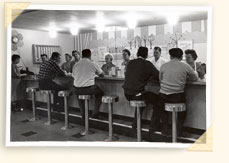 The Dalse Centre is Born The Dalse Centre is Born
Why is Dalse Called Dalse?
Did you know that the Dalse Snack Bar was named after a Montréal service organization called the Dalse Welfare Club? Or that Dalse stands for Devotion, Altruism, Love of Mankind, Service to Community, and Effectiveness?
For over 40 years, Dalse volunteers entertained patients, brought homemade food, and hosted Hanukah parties for Jewish patients.
In 1960, the club donated $25,000 to build a patients' centre in the basement of
Douglas Hall. The Centre included the Dalse Snack Bar, the Clothing Room, where patients could buy donated clothing at reasonable prices and the Corner Store, where other items were put on sale for the patients. There was also a beauty salon and a barber shop. The centre quickly became the social hub of the Hospital for patients and staff.
In 1987, the Clothing Room and Corner Store merged and moved as well as the Dalse Snack Bar to Newman Pavilion. The new location was not as centrally located as the Douglas Hall basement. To compensate, the snack bar began delivering meals to units and offices, recruiting out-patients as delivery people.
Training for the Real World
When the Clothing Room opened in April 1961, volunteers were not allowed to receive special training to serve their customers. The reason: Medical Superintendent Charles A. Roberts, MD, wanted the store to mirror the real world.
According to the Douglas’ second Auxiliary president, Helen Alexander, this rule held for the Dalse Snack Bar as well, "Patients were required to request and pay for the things they wanted. They had to deal with outsiders to [buy] a cup of coffee."
Clothing Room patients paid for their clothes—a fact that rankled some people at first, explained Mrs. Alexander, "At one point, we were criticized for selling…clothes that had been donated… We had to be absolutely firm about this…It gave [patients] a certain pride, a…feeling of independence and the transaction itself was good for them. …Part of the outside world had come into their isolation."
|